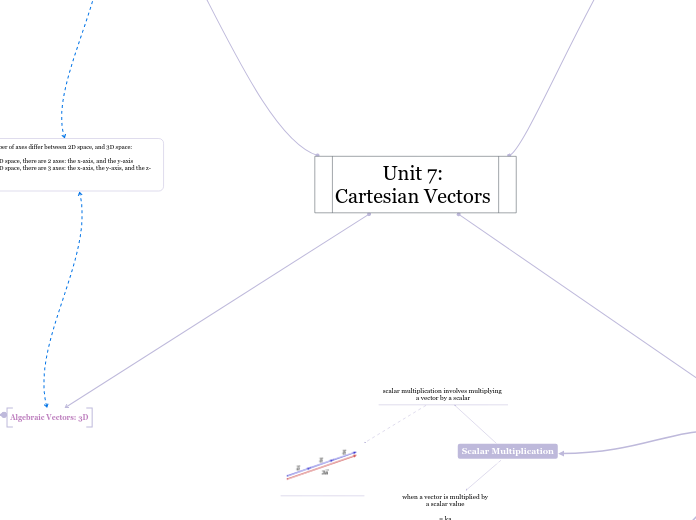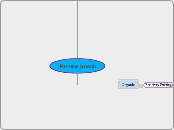Number of axes differ between 2D space, and 3D space:
- in 2D space, there are 2 axes: the x-axis, and the y-axis
- in 3D space, there are 3 axes: the x-axis, the y-axis, and the z-axis
Volume of a Parallelepiped
Formula:
V = A(base) ⋅ height
V = |a ⋅ (b×c)|
Unit 7:
Cartesian Vectors
3 Ways to Multiply Vectors
Cross Product
Properties of the Cross Product:
Distributive Property:
u×(v + w) = u × v + u × w
Associative Property:
k(u×v) = (ku)×v = u×(kv)
u × v = -(v × u)
(u+v) × w = u × w + v × w
if u and v are non-zero, u×v 0
only if there's a scalar such as
u = mv
Cartesian Vectors of the Cross Product:
a × b = [a₂b₃ - a₃b₂, a₃b₁ - a₁b₃, a₁b₂ - a₂b₁]
a × b = (a₂b₃ - a₃b₂)î + (a₃b₁ - a₁b₃)ĵ + (a₁b₂ - a₂b₁)k̂
The Right Hand Rule:
it's used to determine the direction of the
cross product vector
1) index finger is the direction of the 1st vector (a)
2) middle finger is the direction of the 2nd vector (b)
3) the direction where the thumb points gives the
direction of a×b
A vector called the "cross product", has a magnitude equal to the area of the parallelogram the 2 vectors create, and is perpendicular to the 2 vectors.
Formula:
a × b = |a||b|sinθ n
n is the unit vector perpendicular to both a and b
the result of the cross product
is a vector
Determining the Angle Between 2 Vectors:
Formula:
θ = sin⁻¹(|a×b|/|a||b|)
Properties of the Dot Product:
Distributive Property:
u(v ⋅ w) = u ⋅ v + u ⋅ w
Associative Property:
(ku) ⋅ v = k(u ⋅ v) = u ⋅(kv)
For any vector u:
u ⋅ u = |u|²
Commutative Property:
u ⋅ v = v ⋅ u
u ⋅ v = 0 when the vectors
are perpendicular to each other
Cartesian Vectors of the Dot Product:
in R² --> a ⋅ b = a₁b₁ + a₂b₂
in R³ --> a ⋅ b = a₁b₁ + a₂b₂ + a₃b₃
Different Types of Cases:
Case 4: θ is obtuse
e.g., |a| = 10, |b| = 4, θ = 150 degrees
a ⋅ b = |a||b|cosθ
a ⋅ b = 10(4)cos150
a ⋅ b = -34.64 units
cos90 on the unit circle = -√3/2
As a result, the dot product between
a and b will always less than
zero (negative) if the angle is
greater than 90 degrees
Case 3: θ is 90 degrees
e.g., |a| = 10, |b| = 4, θ = 90 degrees
a ⋅ b = |a||b|cosθ
a ⋅ b = 10(4)cos90
a ⋅ b = 10(4)(0)
a ⋅ b = 0 units
cos90 on the unit circle = 0
Under this case, the vectors are
perpendicular/orthogonal.
As a result, the dot product between
aand b will always be zero if the
angle is 90 degrees
Case 2: θ is acute
e.g., |a| = 10, |b| = 4, θ = 60 degrees
a ⋅ b = |a||b|cosθ
a ⋅ b = 10(4)cos60
a ⋅ b = 10(4)(1/2)
a ⋅ b = 20 units
cos60 on the unit circle = 1/2
As a result, the dot product between
a and b will always greater
than zero (positive) if the angle is
less than 90 degrees
Case 1: θ is 0 degrees
e.g., |a| = 10, |b| = 4, θ = 0 degrees
a ⋅ b = |a||b|cosθ
a ⋅ b = 10(4)cos0
a ⋅ b = 10(4)(1)
a ⋅ b = 40 units
cos0 on the unit circle = 1
Formula:
a ⋅ b = |a||b|cosθ
a and b are two non-zero vectors
arranged tail-to-tail forming an angle
the result of the dot product
is a scalar
the angle is between the 2 vectors
Scalar Multiplication
scalar multiplication involves multiplying
a vector by a scalar
when a vector is multiplied by
a scalar value
= ka
Applications
Dot Product
Determining the Angle Between 2 Vectors:
Formula:
cosθ = u⋅v/|u||v|
Projection:
Think of projection like a shadow, where the projection of v onto u is the shadow that v casts on u
Scalar projection tells us
about the magnitude of
the projection
Scalar Projection:
|projᵤv| = |v|cosθ
Vector Projection:
|projᵤv| = (v⋅u/|u||u|)u
|projᵥu| = (u⋅v/|v||v|)v
Work:
The product of the magnitude of the displacement travelled by an object, and the magnitude of the force applied in the direction of the motion
Formula:
W = F⋅d
W= |F||d|cosθ
Measured in Joules, where 1 J = 1 N⋅m
Cross Product:
Torque:
Think of it as a physical quantity that describes the
rotational of turning effort of a force
Formula:
τ = |r × F|
τ = |r||F|sinθ
θ is the angle between the
force and the lever arm
r is the vector determined by the
lever arm from the axis of rotation
measured in metres (m)
F is the applied force
measured in Newtons (N)
Algebraic Vectors: 3D
Vectors in R³
Finding magnitude in 3-space:
| u | = √a² + b² + c²
The unit vectors in 3-space are called the
standard basis vectors: î, ĵ, and k̂
Written as:
î = (1, 0, 0)
ĵ = (0, 1, 0)
k̂ = (0, 0, 1)
Assigned coordinates (a,b,c)∈R³
How to go from O to P?
3) we go c units in the
z-direction
2) we go b units in the
y-direction
1) we go a units in the
x-direction
Points in 3D space can be described using
ordered triples of real numbers
u = any vector in 3-space but position
it so that its tail is at the origin and its
head is at some point P(a,b,c)
(a, b, c) has 2 meanings:
2) the position vector of
point P
1) the coordinates of some
point P in space
Vectors in R²
The coordinates are a
pair of real numbers (a,b)
u = any vector in the plane, but position
it so that its tail is at the origin and its
head is at some point P(a,b)
let u = r
the coordinates of P (a,b)
u can also be interpreted as
the position vector, written
as u = OP = (a,b)
P (position vector) starts at the
origin, and ends at any other
random point
(a, b) are known as the
scalar components
and has 2 meanings:
2) the position vector
of the point P
1) the coordinates of some
point P in the plane
Algebraic Vectors: 2D
Algebraic Vectors
To calculate the magnitude,
use the Pythagorean Theorem:
a² + b² = c²
Can be written using Cartesian coordinates:
- in coordinates form
- in unit vectors form (also known as component form)
unit vector form:
e.g., a = 3î + 5ĵ
î = unit vector of x-axis (1,0)
ĵ = unit vector of y-axis (0,1)
î and ĵ are also known as
the vector components
coordinates form:
e.g., a = (3, 5)
Can be written using polar coordinates:
angle is measured from the terminal arm
(positive x-axis)
Vectors drawn on a coordinate plane,
the tail is at the origin (0,0)
Geometric Vectors:
Is written as a magnitude + a direction
e.g., a --> |a| = 2km [N26°E]
Vectors with no fixed location









